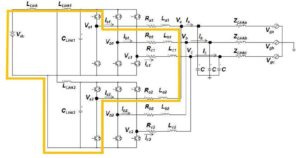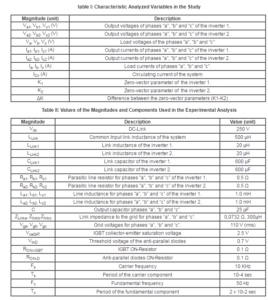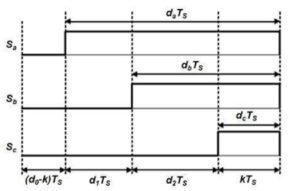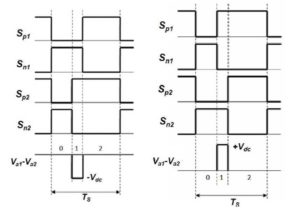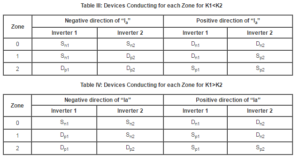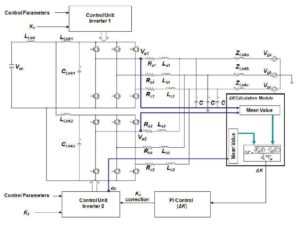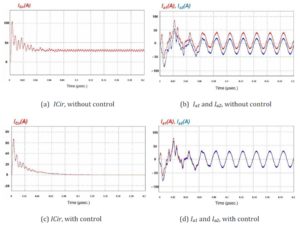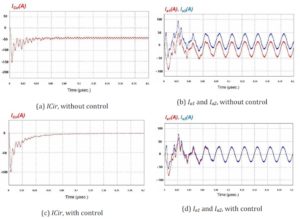Conclusion
This paper has proposed a method to allow a correction action on one inverter, connected in parallel to another, in order to eliminate the circulation current and thereby increase system performance to the maximum possible value, in case of an imbalance in the zero-vector parameters. The proposed procedure is not excessively complex and does not need a high processing capacity. The proposed method has been validated by quasi-functional simulation, based on a simulator already validated with prototypes of previous inverters.
References
Beig, A.R. (2012) “Synchronized SVPWM algorithm for the overmodulation region of a low switching frequency medium-voltage three-level VSI”, IEEE Transactions on Industrial Electronics, Vol 59 , Issue: 12, pp.: 4545 — 4554.
Publisher
Chen, L., Xiao, L., Gong, C and Yan, Y. (2004) “Circulating current characteristics analysis and the control strategy of parallel system based on double close loop controlled VSI”, IEEE 35th Annual Power Electronics Specialist Conference 2004, Vol 6, pp. 4791-4797.
Chen, T, (2006)”Circulating zero-sequence current control of parallel three-phase inverters”, Electric Power Applications, IEEE Proceedings, Vol 153, Issue 2, pp 282-288, 2006.
Chen, T.P. (2012) “Zero-sequence circulating current rduction method for parallel HEPWM inverters between AC bus and DC bus”, IEEE Transactions on Industrial Electronics, Vol. 59 , Issue: 1, pp.: 290 — 300.
Publisher
Das, S. and Narayanan, G. (2012) “Novel switching sequences for a space-vector-modulated three-level inverter”, IEEE Transactions on Industrial Electronics, Vol. 59 , Issue: 3, pp.: 1477 — 1487.
Publisher
Deshang, S., Kai, D. , Zhiquinag, G. and Xiaozhong, L. (2012) “Control strategy for input-series—output-parallel high-frequency AC link inverters”, IEEE Transactions on Industrial Electronics, Vol. 59 , Issue: 11, pp.:4101-4111.
Jiang, Z. And Zhang, Y. (2009) “Sliding mode based zero-sequence current mitigation of parallel-connected power converters”, IEEE International Electric Machines and Drives Conference, Pp. 1658-1663.
Ji, S., Yong, Y. and Chunqing, Q. (2009) “Control of circulating current for direct parallel grid-connected inverters in photovoltaic power generation”, International Conference on Mechatronics and Automation, pp. 3805-3810.
Jinwei, H., Yun, W.L. and Munir, M.S. (2012) “A flexible harmonic control approach through voltage-controlled DG—grid interfacing converters”, IEEE Transactions on Industrial Electronics, Vol.59 , Issue: 1, pp.: 444 — 455.
Kaplar, R., Brock, R., DasGupta, S., Marinella, M. , Starbuck, A. , Fresquez, A., Gonzalez, S. , Granata, J., Quintana, M., Smith, M. and Atcitty, S. (2011) “PV inverter performance and reliability: What is the role of the IGBT?”, 37th IEEE Photovoltaic Specialists Conference (PVSC), pp. 1842-1847.
Kazmierkowski, M.P. and Malesani, L. (1998) “Current control techniques for three-phase voltage-source PWM converters: a survey”, IEEE Transaction on Industrial Electronics, Vol. 45, No 5, pp. 691-703.
Publisher – Google Scholar
Lopez-Lapena, O., Penella M.T. and Gasulla, M. (2012) “A closed-loop Maximum power point tracker for subwatt photovoltaic panels”, IEEE Transactions on Industrial Electronics, Vol. 59 , Issue: 3, pp.: 1588 — 1596.
Publisher
Massing, J.R., Stefanello, M., Grundling, H.A. and Pinheiro, H. (2012) “Adaptive current control for grid-connected converters with LCL filter”, IEEE Transactions on Industrial Electronics, Vol. 59 , Issue: 12, pp.: 4681 – 4693.
Publisher
Mohamed , Y.A.-R.I. (2011) “Mitigation of dynamic, unbalanced, and harmonic voltage disturbances using grid-connected inverters with filter”, IEEE Transactions on Industrial Electronics, Vol. 58, Issue: 9, pp.: 3914 — 3924.
Publisher
Petrone, G., Spagnolo, G. and Vitelli, M. (2012) “An analog technique for distributed MPPT PV applications”, IEEE Transactions on Industrial Electronics, Vol. 59 , Issue: 12, pp.: 4713 — 4722.
Publisher
Schimpf, F. and Norum L. E. (2008) “Grid connected converters for photovoltaic, state of the art, ideas for improvement of transformerless inverters”, Nordic workshop on power and industrial electronics, June 9-11.
Tuladhar, A. Jin, H. Unger, T. and Mauch, K. (1997) “Parallel operation of single phase inverter modules with no control interconnections”, Twelfth Annual Applied Power Electronics Conference and Exposition, 1997, APEC ’97 Conference Proceedings, Vol 1, pp. 94-100.
Tsai, C., Chang, J. Y., Lai, C.M., Juan, Y. L. and Liao, Y. H. (2008), “Modeling of circulating current for grid-connected paralell three-phase inverters”, SICE Annual Conference, Pp. 1319-1322.
Van der Broeck, H. W.; Skudelny, H.- C.; Stanke, G. V. (1988). Analysis and Realisation of a Pulsewidth Modulator Based on Voltage Space Vectors. IEEE Transactions on Industrial Application Vol. 24, No.1, pp. 142-150
Publisher
Xiao, H., Xie, S., Chen, Y. and Huang R. (2011) “An optimized transformerless photovoltaic grid-connected inverter“, IEEE Transactions on Industrial Electronics, Vol.58 , Issue: 5, pp.: 1887 — 1895.
Publisher
Yang, S., Lei, Q., Peng, F.Z. and Qian, Z. (2011) “A robust control scheme for grid-connected voltage-source inverters”, IEEE Transactions on Industrial Electronics,Vol. 58 , Issue: 1, pp.: 202 — 212.
Google Scholar
Ye, Z. , Jain, P.K. and Sen, P.C. (2007) “Circulating current minimization in high-frequency AC power distribution architecture with multiple inverter modules operated in parallel”, IEEE Transactions on Industrial Electronics, Vol 54, Nº 5, pp 2673-2687.
Publisher
Yu, M. , Kang, Y., Zhang, Y., Yin, M., Duan, S., Shan, H. and Chen, G. (2007) “A novel decoupled current-sharing scheme based on circulating-impedance in parallel multi-inverter system”, 33rd Annual Conference of IEEE Industrial Electronics Society, pp 1668-1672.
Zhang, Y. and Jiang, Z. (2009)“Zero-sequence current dynamics in parallel-connected voltage source converters”, IEEE Electric Ship Technologies Symposium, pp. 189-196.
Publisher




